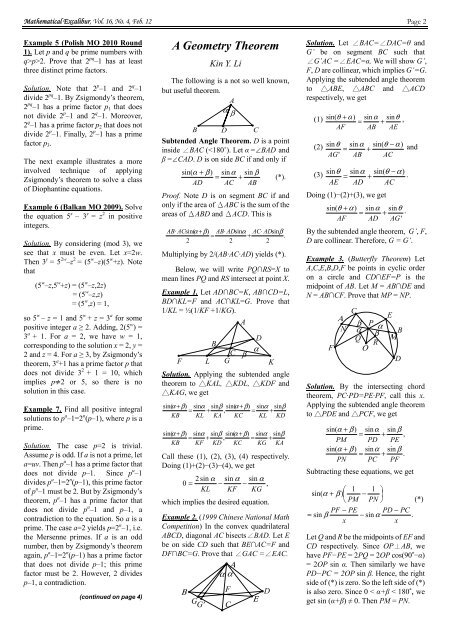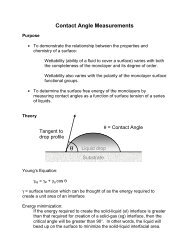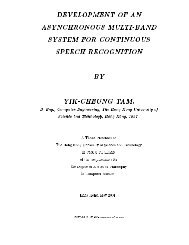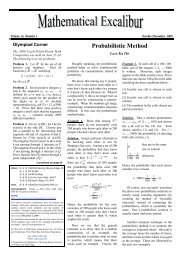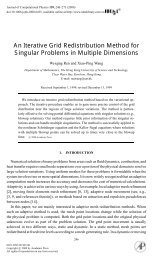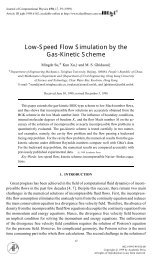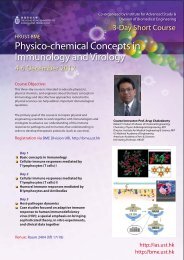Zsigmondy's Theorem - Department of Mathematics - The Hong ...
Zsigmondy's Theorem - Department of Mathematics - The Hong ...
Zsigmondy's Theorem - Department of Mathematics - The Hong ...
You also want an ePaper? Increase the reach of your titles
YUMPU automatically turns print PDFs into web optimized ePapers that Google loves.
Mathematical Excalibur, Vol. 16, No. 4, Feb. 12 Page 2<br />
Example 5 (Polish MO 2010 Round<br />
1). Let p and q be prime numbers with<br />
q>p>2. Prove that 2 pq –1 has at least<br />
three distinct prime factors.<br />
Solution. Note that 2 p –1 and 2 q –1<br />
divide 2 pq –1. By Zsigmondy’s theorem,<br />
2 pq –1 has a prime factor p 1 that does<br />
not divide 2 p –1 and 2 q –1. Moreover,<br />
2 q –1 has a prime factor p 2 that does not<br />
divide 2 p –1. Finally, 2 p –1 has a prime<br />
factor p 3 .<br />
<strong>The</strong> next example illustrates a more<br />
involved technique <strong>of</strong> applying<br />
Zsigmondy’s theorem to solve a class<br />
<strong>of</strong> Diophantine equations.<br />
Example 6 (Balkan MO 2009). Solve<br />
the equation 5 x – 3 y = z 2 in positive<br />
integers.<br />
Solution. By considering (mod 3), we<br />
see that x must be even. Let x=2w.<br />
<strong>The</strong>n 3 y = 5 2w –z 2 = (5 w –z)(5 w +z). Note<br />
that<br />
(5 w –z,5 w +z) = (5 w –z,2z)<br />
= (5 w –z,z)<br />
= (5 w ,z) = 1,<br />
so 5 w – z = 1 and 5 w + z = 3 a for some<br />
positive integer a ≥ 2. Adding, 2(5 w ) =<br />
3 a + 1. For a = 2, we have w = 1,<br />
corresponding to the solution x = 2, y =<br />
2 and z = 4. For a ≥ 3, by Zsigmondy’s<br />
theorem, 3 a +1 has a prime factor p that<br />
does not divide 3 2 + 1 = 10, which<br />
implies p≠2 or 5, so there is no<br />
solution in this case.<br />
Example 7. Find all positive integral<br />
solutions to p a –1=2 n (p–1), where p is a<br />
prime.<br />
Solution. <strong>The</strong> case p=2 is trivial.<br />
Assume p is odd. If a is not a prime, let<br />
a=uv. <strong>The</strong>n p u –1 has a prime factor that<br />
does not divide p–1. Since p u –1<br />
divides p a –1=2 n (p–1), this prime factor<br />
<strong>of</strong> p u –1 must be 2. But by Zsigmondy’s<br />
theorem, p a –1 has a prime factor that<br />
does not divide p u –1 and p–1, a<br />
contradiction to the equation. So a is a<br />
prime. <strong>The</strong> case a=2 yields p=2 n –1, i.e.<br />
the Mersenne primes. If a is an odd<br />
number, then by Zsigmondy’s theorem<br />
again, p a –1=2 n (p–1) has a prime factor<br />
that does not divide p–1; this prime<br />
factor must be 2. However, 2 divides<br />
p–1, a contradiction.<br />
(continued on page 4)<br />
A Geometry <strong><strong>The</strong>orem</strong><br />
Kin Y. Li<br />
<strong>The</strong> following is a not so well known,<br />
but useful theorem.<br />
A<br />
α β<br />
Solution. Let ∠BAC=∠DAC=θ and<br />
G’ be on segment BC such that<br />
∠G’AC =∠EAC=α. We will show G’,<br />
F, D are collinear, which implies G’=G.<br />
Applying the subtended angle theorem<br />
to △ABE, △ABC and △ACD<br />
respectively, we get<br />
(1)<br />
sin( θ + α ) sinα<br />
sinθ<br />
= + ,<br />
B D C<br />
AF AB AE<br />
Subtended Angle <strong><strong>The</strong>orem</strong>. D is a point<br />
inside ∠BAC (


